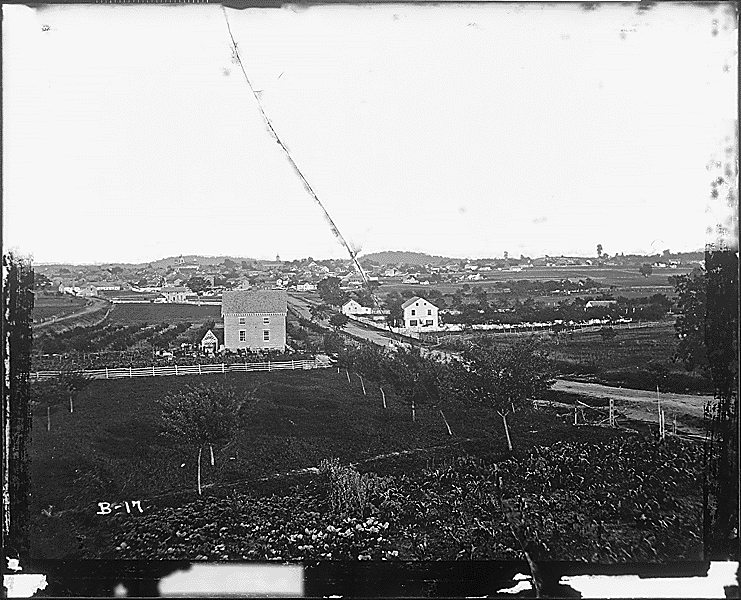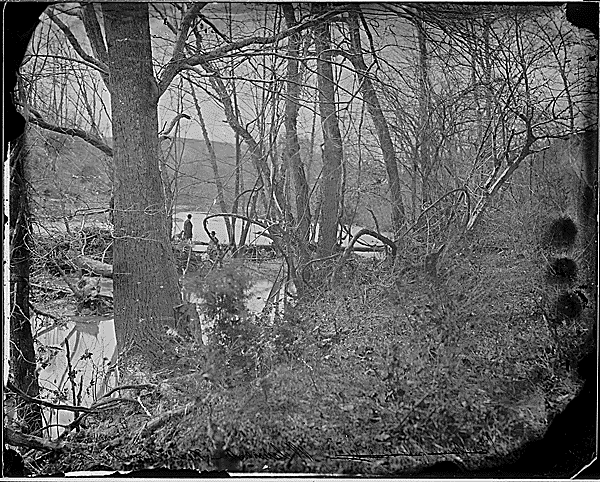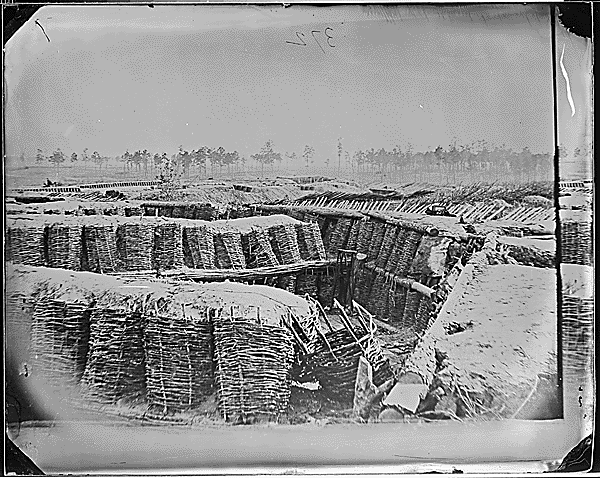After the brutal struggle at Chancellorsville, Company A returned to camp and remained encamped until June 5, 1863. This month of encampment allowed another chance to escape the army, and one member of Company A took advantage. Calvin Thompson, 35 years old, deserted the Confederate lines.
On June 5th, the army broke camp and began to move. Confident after the victory at Chancellorsville, General Lee felt a decisive victory in the North would end popular support for the war; Company A, along with the rest of the Confederate forces, were on their way to Pennsylvania.

On July 1st the Union and Confederate Armies collided at Gettysburg, Pennsylvania. Company A was part of the division of forces that initially encountered the Federal forces along the road running into town. After initial fighting, the Union forces fell back to Seminary Ridge, where they set up defensive positions. Company A was in the center of the line that was created to attack this position. The assault on Seminary Ridge was a disaster. Union artillery, firing canister shot from less than 100 yards away, mowed down the approaching Confederate forces. Eventually a hole in the Union lines was exploited and Company A was added to the forces assaulting this position. Soon the Union forces were routed and the newly conquered ridge would become the site of Lee’s headquarters.
During the second day, Company A saw little combat. Their regiment, the 34th North Carolina, had lost half its number in the previous day’s assault and spent the day attempting to reorganize. During that time the large Union and Confederate forces fought their way to a stalemate. However, on the third day of the battle, Company A became part of the assault on the Union line known as “Pickett’s Charge,” an ill conceived attempt to break through a heavily fortified Federal position on Cemetery Ridge. On the morning of the charge, Friday, July 3rd, the entire regiment numbered only 150, Company A had only 11 members in condition to fight. This skeletal force was asked to march across almost a mile of open field and attack a heavily fortified Union position that was awaiting their assault. Although they came close enough to the Federal lines for some members of their regiment to be taken prisoner, neither Company A, or any other Confederate force, was able to breach the Union line.
Several Ashe County natives suffered at Gettysburg. James Bare, who had just two months prior joined the company after marching from Ashe, was wounded in the hip. George Woodie, whose brother, Nelson C. had just been discharged with an injury suffered at Fredericksburg was himself wounded in the head. Wiley Taylor, who had deserted to return home during the winter had returned to the company in time to be taken prisoner at Gettysburg – he would spend the rest of the war imprisoned in Maryland. John Richardson, who had been shot in the shoulder at Chancellorsville was also taken prisoner. Hamilton K. Koontz, who had been shot in the arm at Ox Hill and shot yet again at Chancellorsville, was once more wounded at Gettysburg. He would soon be promoted to sergeant, no doubt in honor of his resilience and determination in battle.
Following their defeat, the Confederate forces, disheartened and caked in mud, began a weary trudge back to Hagerstown, Maryland. Through the rain and dismal, overcast skies they subsisted on half rations. On the night of July 13th, the entire Army of Northern Virginia began crossing a makeshift pontoon bridge that had been hastily built to accommodate their retreat. To protect the retreating forces, the 34th North Carolina was formed into a battle line about a mile away from the pontoon bridge. Consequently, they were one of the last groups to cross the river. By the time they crossed the river, Federal forces were quickly approaching. To prevent the Federals’ river crossing, the makeshift pontoon bridge was cut loose and those Confederates left north of the river were abandoned to enemy forces. Two members of Company A, Calvin Osborne and John B. Williams were taken prisoner before they could cross. Both would remain in Federal custody for the remainder of the war.
Two weeks later, Company A was again being pursued by Union forces, this time at Brady Station. On a march towards Orange Courthouse, they were surrounded by Federal cavalry. They were rescued at the last minute by reinforcements, but Levi Cox, whose brothers Hiram and David had been killed a year earlier at Chancellorsville, was captured. He would spend the remainder of the war imprisoned in Maryland.
The Gettysburg Campaign, though tragic for the Confederacy, was short, and soon Company A was back in their winter camp, this time at Orange Courthouse. Sensing the war slipping away from them, Confederate state governments began aggressively requiring military service from all those who had yet to volunteer. Residents were encouraged to join up with units made up of other locals, and, consequently, two Ashe County residents arrived in camp during the winter of 1863 to increase the ranks of Company A: Robert Elliot and John Koontz, whose brother Hamilton K. had been serving since 1861, suffering multiple wounds in the process.
Despite these additions, the ranks of Company A continued to decline through the autumn. William Patrick and Andrew Pennington both deserted on August 27th. Zadoc Osborne, who had only joined the company in March, also deserted in August. The Company bugler, John Waggoner deserted sometime prior to September. James Bare, recently wounded at Gettysburg was captured after a brief battle at Bristoe Station; he chose to enlist in the Union army rather than remain a prisoner.
During the cold winter months, soldiers leaving camp without permission and outright desertions increased rapidly. At one point, only four members of Company A were present in camp: Sergeant Hiram Stamper and three privates. William H. Absher, a native of Wilkes County who had enlisted in Ashe, deserted; however, he was captured during the attempt and executed in camp on April 18th, 1864. Most other deserters were able to get away. William Clary, John A. Johnson, Mathias Poe, and James Waggoner had all permanently disappeared from the roster by March of 1864. The brutal cold of the winter did further damage to the group. Wiley Bare, who had deserted in 1862, was captured in the winter of 1864 and sentenced to be executed. However, his sentence was set aside due to “partial derangement.” His feet became so frozen while in camp that he fled and turned himself in to Union forces. Calvin Woodie, who had recently been captured for attempted desertion, was awaiting court martial when he asked to use the latrine and instead ran. The guard’s gun misfired, allowing Woodie to escape his fate; he fled into Union lines, seeking treatment for his frostbitten feet. He would remain in Federal custody for the rest of the war.
Before the beginning of the 1864 Campaign in May of 1864, only 31 of the original enlistees remained. 40% of the soldiers who had been present at the start of the 1863 campaign were no longer members of Company A. However, with the South clearly beginning to lose the war, what little resolve to stay and fight was quickly evaporating; as natives of poor mountain counties that were largely free of slaveholders, the members of Company A saw less and less good coming from the war effort and were especially prone to desertion. The 34th North Carolina Regiment was made up of 10 companies. By the end of the war the regiment had noted 387 instances of desertion or soldiers reported absent without leave. Of these 387 incidents, 146 of these reported incidents were from Company A, whose members frequently deserted and returned several times before permanently abandoning the army. By the end of 1864 only a shadow of Company A’s original force would still be present.

Interestingly for Company A, May of 1864 found them exactly where they had been in the spring of 1863: Chancellorsville. Here the Union army, attempting to break through Lee’s lines, attacked the Confederates in a dense growth of forest. This confining setting led to the battle’s eventual name: The Wilderness. Company A was situated to the right of the plank road, the same road they had used as cover during the Chancellorsville battle, as they were attacked throughout the day in the dense forest by at least six separate Union assaults. The next day, May the 6th, they were driven back by an aggressive Union assault, but soon joined a counterassault being orchestrated by Confederate General Longstreet. After another full day of vicious fighting, the two armies ended up in a stalemate.
The horror of the Wilderness battle was remembered by many veterans to have occured after the end of the fighting. Sparks and spent wadding from soldier’s muskets caused fires to break out all through the underbrush of the forest battlefield. These fires rapidly spread and gathered intensity, trapping many wounded soldiers still unable to move. Many of the immobilized wounded were burned to death through the evening and night of May the 6th
Like the first battle at Chancellorsville, the Battle of the Wilderness was hard on Company A, whose numbers were already dwindling rapidly. George W. Woodie, the last of the brothers who had enlisted in August 1861 left alive, was shot through the right foot and retired to the invalid corps. Wesley Brown was shot through the hand; he would be discharged from service and not return.
Over the next few weeks, the Company would be engaged at Spotslvania Courthouse, a vicious gun battle that lasted all day; however, Company A’s placement behind fortification kept any members from being killed or injured. By the end of May, they had moved again, and were once again under assault from Union forces, now being commanded by Ulysses S. Grant, whose battle plan was to constantly and aggressively assault Lee’s weakened force. At Hanover Junction, they once more attempted to fend off a Union assault. Company A was part of the force tasked with blocking the Union advance along the North Anna River. Initially they were tasked with supporting another brigade, but after that brigade collapsed under Union pressure, Company A found themselves in the front line of the battle. This attack proved costly for all involved. Three color bearers for the 34th Regiment, of which Company A was a part, were shot down in succession. Only one member of Company A, Sanders Thompson, suffered injury. However, several members were captured by Union forces. Hiram Stamper, Hamilton Taylor, Alexander Taylor among those. Mathais Brown, who had won accolades at the battle of Chancellorsville, would also spend the remainder of the war imprisoned. Henry B. Woodie, was also captured and would die in Federal prison of gastroenteritis one month later. One of the captured members of Company A was James T. Blackburn, a conscript from Wilkes County who had only been with the company since January. When he was captured, Federal soldiers noted on his record that he “Never thought the south was right. Forced into the service. Wishes to go to Pennsylvania and take the oath.”
Through the rest of 1864, the tattered Confederate Army found itself being flanked and retreating as Grant’s superior forces drove them closer to Richmond. This extended retreat, which stretched from one battle to the next was a deadly one for both sides. At Cold Harbor, the Union forces suffered staggering losses, taking 7,000 casualties within the first eight minutes of the battle. However, at this battle, the Confederate positions, stationed behind defensive works, suffered lightly. By fall of 1864, Grant and Lee were engaged in a stalemate outside of Petersburg, Virginia. Company A found itself manning a section of trenches being built southwest of the city. They spent their days digging, hewing logs, and constructing fortifications to fend off any Union assault. Here the dug in Confederates would gaze out at a surrounding Union seige for nine months.

Around this time, the Confederate Congress selected several regiments for recognition. The 34th North Carolina, of which Company A was a part, was one of the regiments chosen for this honor. However, this accolade did little to aide the morale of the men in the trenches around Petersburg. This extended, demoralizing siege eroded away what little support still existed among members of Company A. Sanders Thompson, wounded at the North Anna River, deserted. Henry Bare was arrested while attempting to desert. John F. Shepherd, a 43 year old enlistee who had deserted the army in the summer of 1862, was forcible returned to the ranks in early 1864. Shepherd immediately fell ill and was discharged due to age in the winter of 1864.
Company A briefly saw combat during this period. On August 24th, they left the trenches around Petersburg and marched to nearby Ream’s Station, a spot on the Weldon Railroad, which had just been occupied by Federal forces. Company A was a part of the larger Confederate force tasked with dislodging the Federal presence. After an all day battle in which the Confederate troops relentless attacked an pursed the entrenched Union forces, the Confederates regained possession of the railroad. During the course of the battle, Company A suffered a single casualty: Joshua Richardson, who had been 19 at the time of his enlistment, was wounded and had his left arm amputated on the field by the regimental surgeon. He eventually recovered and was discharged from the army due to disability.
Despite this minor victory, the end was near for the Confederate Army, and for Company A. As the Petersburg siege ended in the spring of 1865 only three members of the original Company formed in Ashe County remained in the army. 97% of Company A had either died of disease or injury, been killed, been captured, or deserted.
1865 found Company A on the run. Fleeing Petersburg, they marched for miles, following the Appomatox River, pursued closely by Grant’s cavalry. Arriving at Appomatox Couthouse Company A was ordered to form a defensive line. 25,000 Confederates found themselves totally surrounded by 125,000 Federal troops. General Lee made the decision to spare any further violence and surrender his troops.
At the surrender, a mere handful of Ashe County residents stacked their weapons in front of the victorious Union forces. Their ability to survive and maintain committed to their cause is quite a testament of personal fortitude. Of the original enlistees from August of 1861 the following troops remained: Jacob Bare, who had been wounded twice in unrecorded battles and who had deserted each winter of the war to return home to Ashe, diligently returning to his post each spring; Elbert J. Wiles, who, after being wounded in the arm at Fredericksburg, had spent the majority of the war as a hospital guard rather than return home, and James Calton Miller, who had risen in rank from private to sergeant in the war, having been wounded in the left arm at Ox Hill. He had worked as a courier for much of the war and, despite having briefly been detained as a prisoner, had been present at every regimental muster.
After the war, many soldiers who had been captured were released and returned home, where they found their former comrades in arms awaiting them. Some had been formally discharged, some had been wounded, some had deserted, but all had seen first hand the horrors and hardships of the Civil War. Although many of these same individuals would go on to live for several more decades and accomplish much in civilian life, they would never forget the places, the actions, and most importantly, the people, they had seen while marching as a member of Company A.
My GG Grandfather was in Company D of the 34th with his 2 brothers. I think Company D has a lot of boys from Iredell and Rowan Counties. They lived on a farm between Statesville and Mooresville. Their farm I believe is under Lake Norman now. His name is Marshall A. Douglass. His brothers would not let him join when they did because he was not 18. After his 18th birthday he ran away from home and traveled over 200 miles to find them and join the company. He was wounded during Pickett’s Charge and taken prisoner by the 8th Ohio and sent to Point Lookout, Md. He was later exchanged and then served in the Provost. I am very impressed which your piece here. It is very thorough and well documented. Good job! I would be interested in some of your sources that might have some information on Company ! My email is below..